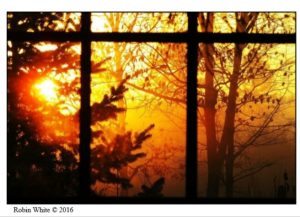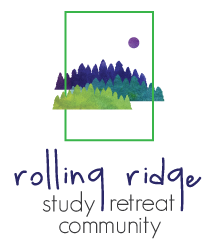Winter is my favorite season on the mountain. Summer was fine enough for a kid in suburbia, poolside, no school. But as an adult – a postpartum adult – I find summer absolutely suffocating. Especially on the mountain. The heat. The thick walls of green. The thicker walls of gnats. Certain community members’ insistence that we help in the garden if we want to eat the strawberries – suffocating!
But in the winter the world opens up. You can walk anywhere, without knee-high stilt grass hiding brambles, rattle snakes, or ticks. In fact you can see straight through to our namesake, the rolling ridges, sometimes sparkling with ice, long-since melted on our corner of the world, other times lit in golden sunlight while our side of the mountain seems cloudy and gray. Neighbors, worlds apart.
And then when it snows, time loses its power to separate. You find yourself following the same labyrinth path of the deer, long gone and yet still here, their hooves having left a mark on this shared path.

It was this way when I walked out of hunter’s field one evening and saw the setting sun through the open blinds of the forest. On this high ground there is an old grave marker for J.T., a two year old who died shortly after his birthday in the year 1800.
I never noticed before how his stone faces due west, directly towards that setting sun.
And suddenly I could see in wisps and shadows, like footprints in the snow, who has come before. I believe it was around the very end of the 18th century that our mountain had been cleared and some of the loggers brought their families here to carve out a life farming (a nearly impossible task, we’re learning).
I stand there for a moment, where J.T’s mother must have stood many moments, with the sun setting, the world on fire, the darkness winning. I feel that mother’s heart, the heart we all embody when it’s time to storm or soothe. She chose this spot to lay her son down. This must have been, as it still is now, a special place. High. Flat. A family could picnic here. The children could play here. That is where I would want J.T. Close to all that happiness and togetherness and uninhibited beauty. Not even Christ Church was around then – a completely open horizon.
It is tradition to bury to the east, welcoming the new day, the second coming. I could understand why someone who lives on this mountain would be more oriented to the west. It’s a place where you have to see each day out, and then have some comfort slipping into the darkness of night or winter, for a time. I believe that is why so many sages and scholars and servant-hearted are drawn here.

Now here I come, tramping along in my giant muck boots, a different kind of mother of a two-year-old, feeling absolutely ridiculous to consider myself isolated or overworked or darn near ready to give up on this farming thing (even if it does mean no more strawberries).
There is long history, even if a short list, of folks who have woven their lives into this particular patch of Earth. Our stories are not the same. And yet, we hold so much in common. Time and other barriers disappear when you find yourself following the same labyrinth path of someone who has walked before you. The weight of our lives leaving an impression in the snow that holds it through small eternities for the next wanderer to wonder over.
May our prints be found to pause at times facing west, reminding those who come after to take in that setting sun, to hold each day to the last.

